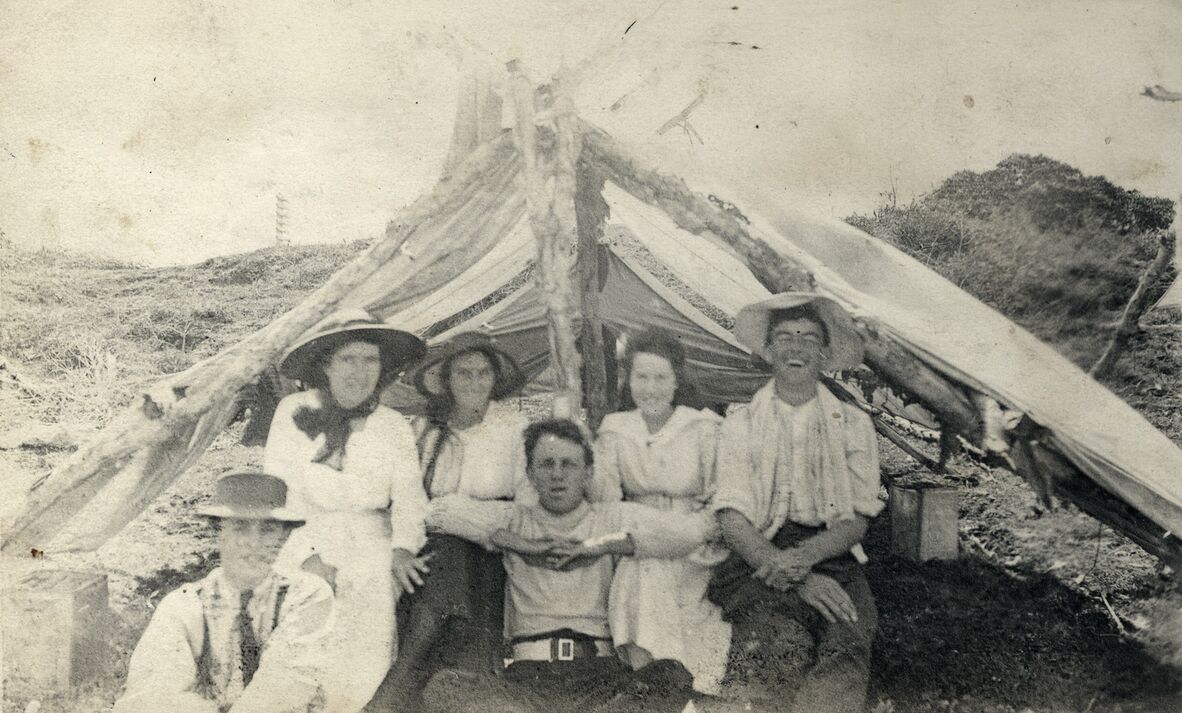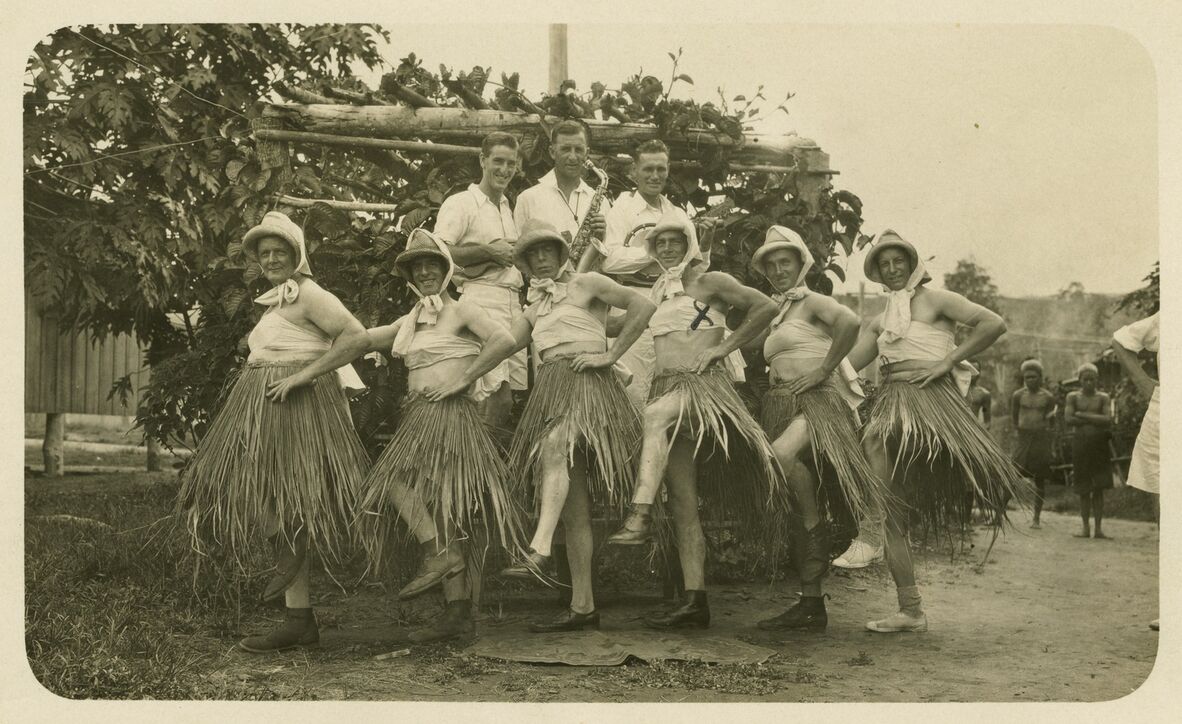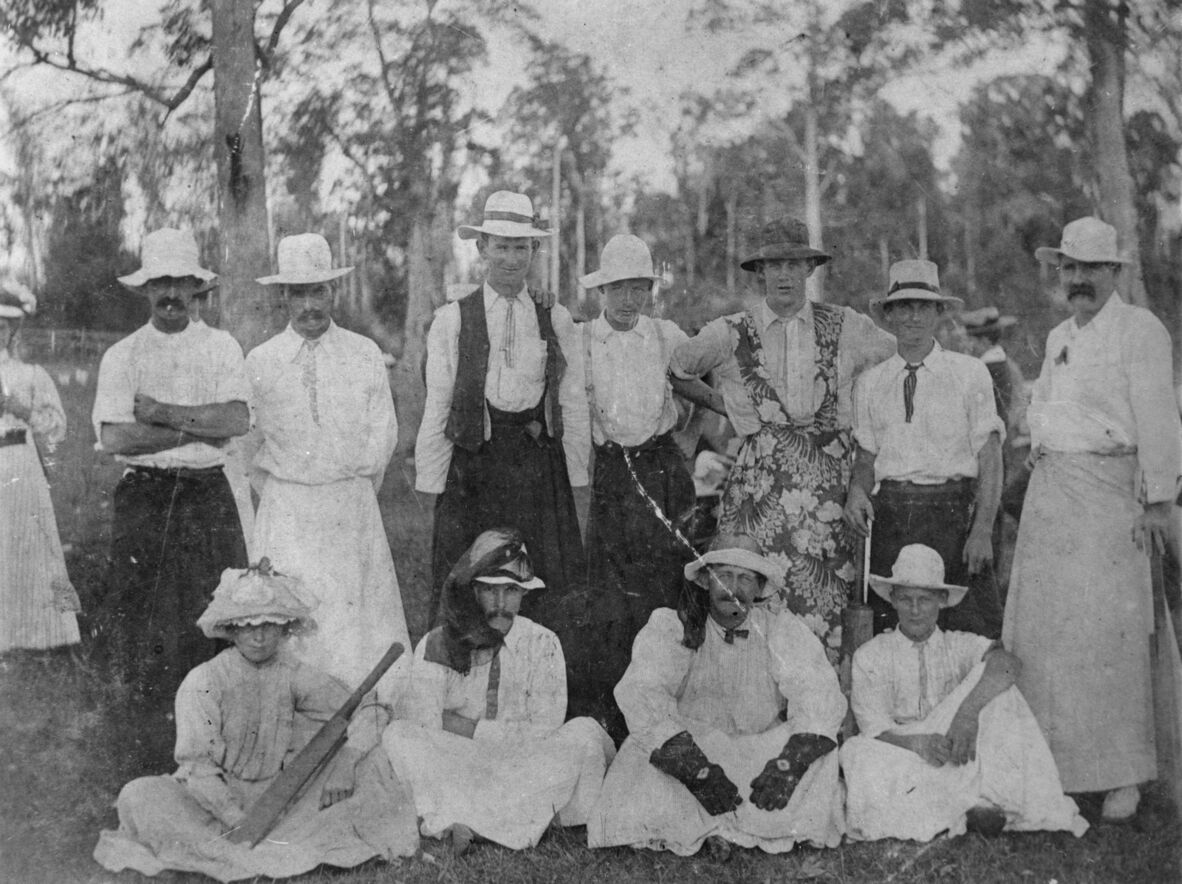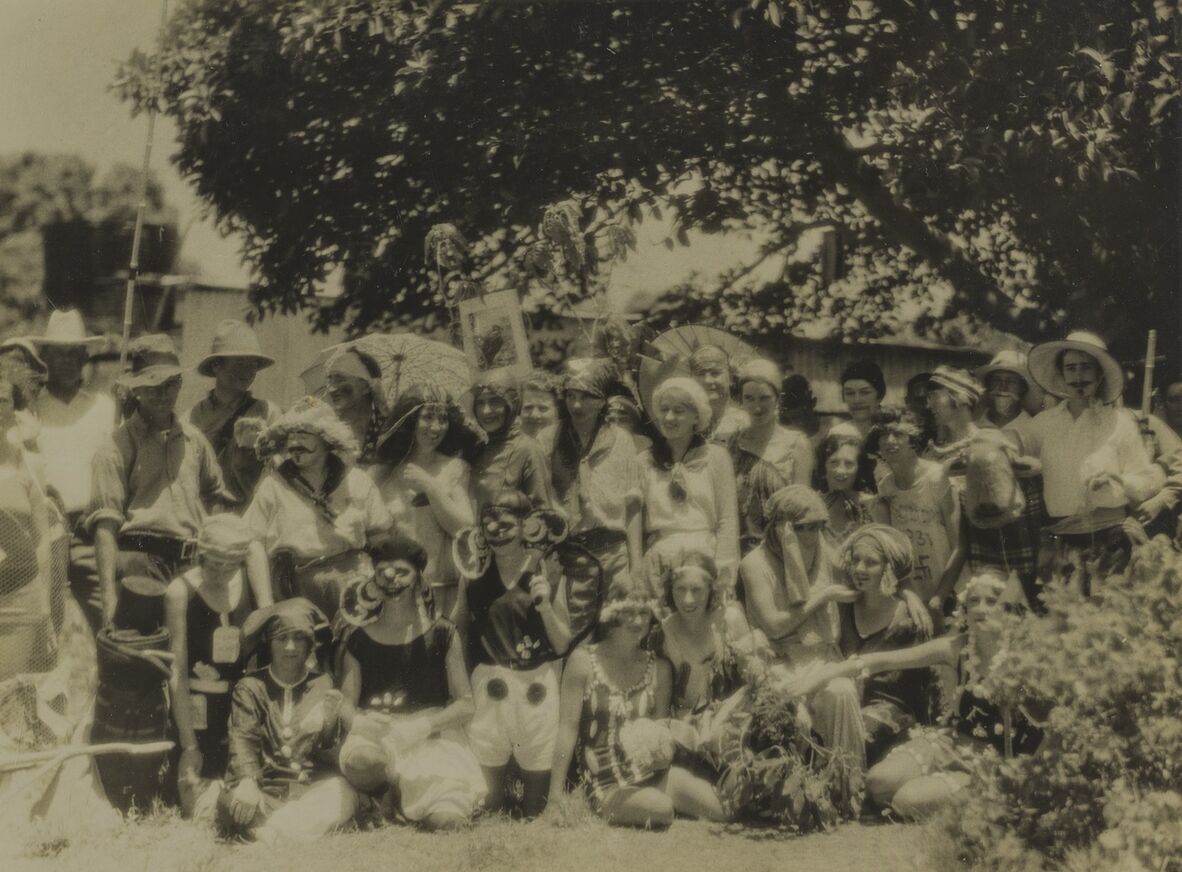Queering the Lens: Cross-Dressing in Family Photograph Albums
By Dr Marion Stell and Professor Celmara Pocock, 2025 Rainbow Research Fellows | 19 May 2025
This blog was written by 2025 Rainbow Research Fellows, Dr Marion Stell and Professor Celmara Pocock.
This is part of their research on the project: Queering the Lens: Cross-Dressing in Family Photograph Albums.

Campers at Redcliffe, c1922. 6147 Trackson Family Photograph Albums, John Oxley Library, State Library of Queensland.
Image number: APA-003-01-0017.
Why are you looking at this photograph? What catches your eye? The rustic tree branches of the makeshift tent, its stretched canvas, the six campers or day trippers aware their photo is being taken? What do you imagine – is it the unseen seventh person with a camera? Is there a second tent just visible to the right? How long have they been here? How hot is the day? Why aren’t they swimming? Do the two supply boxes hold food and drink for the party?
What are you looking for – the history of Redcliffe, the evolution of camping, life at the beach, young people’s leisure and recreation, the changing landscape of Queensland’s coastline?
The photograph is from the Trackson Family Photograph Album (JOL ACC 6147). It is part of a digitised collection and is available and searchable online. The online caption reads: ‘Phil Trackson and Cyril Lambeth camping at Redcliffe, c1922.’ To find it you would need to search on either name, or the terms ‘camping’ and ‘Redcliffe’. A further catalogue summary notes: ‘Young people taking shelter under a shade tent, out for the day at Redcliff (sic). Cyril Lambeth is identified as the last man on the right.’
If you have time, you might find it by browsing the three family albums in the Trackson collection, and stumble upon it serendipitously, as we did. Look closer and what do you see? The laugh says it all.
On closer inspection, we see that Cyril Lambeth, the last man on the right, has appropriated one of the young women’s hats. He wears it for the photograph, his head back laughing tells us that wearing this hat is humorous. This is not his hat. It belongs to a woman. For a man to wear a woman’s hat is transgressive behaviour, and while not full cross-dressing, it speaks to a knowledge of public gender non-conformity as a way of fun.
Transgressive Behaviour
Cross-dressing – that is men dressing as women or women dressing as men – is a practice that deliberately blurs the boundaries of gender and sexuality and challenges us to look at gender roles in our society.
In the twentieth century, cross-dressing was a transgressive behaviour that challenged societal norms and frequently resulted in harassment, persecution and the threat of incarceration for queers who engaged in the activity. Those masquerading as the opposite gender could be subject to criminal prosecution under vagrancy and offensive and indecent behaviour laws. But cross-dressing could also be performed with impunity when given licence by humour and entertainment.
Despite the fact that cross-dressing was often regarded as deviant and immoral, especially when erroneously conflated with queer sexualities and genders, it was a widespread and relatively common form of entertainment throughout the twentieth century, particularly the first part of the century. In situations with limited entertainment, individuals, families and groups made their own entertainment in parlour games, parties and music. Fancy dress was a popular form of entertainment, and dressing in the attire of the opposite gender was a relatively easy way to dress up for such occasions. It could be as simple as borrowing a hat, scarf or cane. But men seemed to especially revel in the opportunity to don a dress, even a grass one.

Australian men who were working gold dredging in Bulolo, Papua New Guines, entertain their fellow workers c1930s. Their skirts are made from local materials. 28942 Hubert Archibald Williamson New Guinea Photographs. John Oxley Library, State Library of Queensland, Image number: 28942-0002-0007.
Given the widespread nature and popularity of the practice, and its association with events or parties, photographs that capture instances of cross dressing are plentiful. But the humour that enabled people to cross-dress without persecution, also masks the more deliberate intent of gender inversion at play.
Consequently, many of these photographs are catalogued according to the type of event or gathering – party, picnic or pitch, and do not identify cross-dressing or gender. The photographs in the State Library of Queensland collection are thus largely unseen, uncaptioned, and uncatalogued as queer history. This project seeks to recover the rich history of these images as part of the queer story of Queensland and Australia.

Fancy dress cricket matches were popular in Queensland from the late 1880s through to the Second World War. Here the wardrobes of wives and sisters may have been utilised to supply the fancy dress in a match in Yandina, c1907. John Oxley Library, State Library of Queensland. Negative number: 3457.
Serendipitous searches of the State Library of Queensland catalogue – and a bit of an inkling from our queer sensibilities and prior photographic research projects on sport and Great Barrier Reef holidays – allowed us to quickly find some starting images for the project.

A group on a scientific expedition to the Great Barrier Reef entertain with some fancy dress, c1931. Some costumes would have been deliberately included in their luggage to the Norwest Island or loaned between women and men. OM91-98, Embury Family Papers, John Oxley Library, State Library of Queensland. Image number: OM91-98-0001-0038.
But a systematic approach to the collection is allowing us to find more examples in more contexts and situations. Searching each family album in the State Library of Queensland has refined how we search and how we identify and define cross-dressing and queerness. There are some very obvious examples; burly men with beards and moustaches in ill-fitting dresses, or women wearing suits or trousers at times when such attire was reserved for men.
Women in particular, require props to cement their dress as masculine, especially as women’s clothing changed during the twentieth century. Women cross-dressing as men are sometimes harder to recognise, and can be easily mistaken as young men or boys if simply dressing in trousers and shirts. They rely on props to make their masculinity more obvious, often holding themselves proud and adopting an exaggerated confidence.
Men, on the other hand, often add a simpering pose or affect other mannerisms or activities usually attributed to women. But a simple item or prop can be used without full cross-dressing to indicate the other gender; a parasol, cigar, hat or cane acting as effective signifiers of gender, particularly in the early twentieth century. It takes a closer look at group photographs to recognise an item out of place.
Our initial searches have also helped us to refine what is not cross-dressing. Men in dresses or skirts is an overwhelmingly easy to read form of cross-dressing. But exceptions abound in well-known examples of masculine dresses and skirts in the form of Scottish kilts, Samoan sarongs and lavish religious regalia. Such culturally sanctioned clothing breaks the conventions of gendered clothing without challenging gender norms. Similarly, early twentieth century women’s clothing was highly impractical for any kind of physical activity, and so women sometimes wear men’s clothing, not as an act of entertainment or transgression but as practical way to ride a horse or muster cattle.
Lifting the lid on archive boxes and tenderly opening fragile covers of family albums, we are reading these photographs anew – we are queering the lens, by finding the mischief of crossdressing in twentieth century Queensland.
Call out for your photographs!
If you have photographs in your own family albums that document instances of cross-dressing in the twentieth century, please get in touch with us via: qldmemory@slq.qld.gov.au
Dr Marion Stell and Professor Celmara Pocock, 2025 Rainbow Research Fellows, State Library of Queensland
Read other blogs by Marion and Celmara
- Cruising: Cross-Dressing at Sea
- Queer Eye: How to Identify Cross-Dressing in Family Photograph Albums
Read more blogs about Queensland's LGBTIQA+ history from previous Rainbow Research Fellows.
The 2025 Rainbow Research Fellowship is generously supported by the Queensland Library Foundation.
Dr Marion Stell and Professor Celmara Pocock were awarded the 2025 Rainbow Research Fellowship for their project, Queering the Lens: Cross-Dressing in Family Photograph Albums.
Comments
Your email address will not be published.
We welcome relevant, respectful comments.